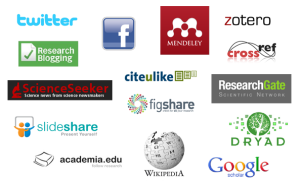My interest was caught by the book mentioned in a previous post to this blog by Atila lamarino1. In The Half Life of Facts, the author Samuel Arbesman ponders the constant changes in what we know about our world and explores the dynamic and changeable character of knowledge as a vital characteristic of scientific research, because science is constantly reviewing its established truths in order to take account of new discoveries, in an atmosphere of constant renewal (Arbesman 2012).
Such renewal of science has made possible countless gains for Humanity, such as the emergence and expansion of Internet based technologies and tools, which change the world and science itself, making possible new opportunities for the development of both the methodology of science and its communication, evaluation, promotion and validation certification – activities which permeate the complex system of research. Perhaps the most crucial of these is scholarly communication.
In fact, science only comes to fruition when the results of its research are made public and it depends at its heart on communication to give concrete expression to its research results:
[…] scientific and technical activity are the source from which springs scientific and technical knowledge which will transform itself, after it has been recorded, into scientific and technical information. But, conversely, these activities only exist, only become reality, by means of this information. Information is the life blood of science. Without information, science can neither develop nor live. Without information, research would be fruitless and knowledge would not exist. A unique lifeblood, which is continually produced and renewed, the only objective of information is to circulate, and above all, to circulate freely. (Le Coadic 1996, p. 27)
Scientific and technical information circulates by means of specialized publications which were first conceived over 300 years ago: scientific journals. The technology of printed scientific journals has been around for a long time, and in the new technological environment, these publications have migrated to an online environment, making it easier to publish and access them and also causing the flood of information commented on by Atila, which even includes the latest pingback relating to the previous posting. This flood of information owes its existence to the exponential growth in scientific literature, taking place in era also of exponential change.
This remarkable growth in the literature of science brings with it a problem: the difficulty of evaluating scientific production, since “one way of evaluating the quality of a publication is to ascertain the level of interest shown by other people in that particular piece of research “(Meadows 1999, p. 89). There is a simple way to substantiate this interest – and that is to count the number of citations received by the published piece of research. This method brings together quantitative studies of science, scientific information, the phenomena of information, and online data : bibliometrics, scientometrics, informetrics and webometrics. These metrical investigations provide data and indicators which are extremely useful to funding agencies, academic institutions, and even those organizations responsible for planning and management of Science and Technology policies when they need to evaluate both research and the researchers themselves. One of these yardsticks is the famous Impact Factor, an indicator created in the 1960’s, which, although hotly disputed, is still widely used for the evaluation of scientific production.
However, given this new environment of exponential change in the digital age, citations for published literature (The Impact Factor is a citation-based indicator) are turning out to be an inadequate measure for indicating “the level of interest shown by others in a particular piece of research”. There are studies (Lozano 2012) in existence which show a growing decay in the relationship between the journal Impact Factor and citations.
As Atila said, the reader’s attention is a commodity which is in increasingly short supply. However, the relationships and interactions that occur between individuals who share common interests , with the exchange of information on what is interesting and worthy of closer examination, helps act as a filter for the flood of information which assails all those who work in the field of research.
These interactions within the scientific community always took place by means of informal exchanges using spoken and written channels of communication (personal contact, telephone conversations or via email). They were conversations between peers and small groups which took place in social or research related situations – gatherings, events, laboratory visits, meetings, etc., and were characteristic of the so called invisible college. And even this communication dynamic which is characteristic of the invisible college was changed by the new virtual technology platforms on the Web, in logical networks which are multidirectional, associative and interactive by nature. These serve to intensify the dynamic of these interactions which are informal exchanges with the participation of peers and other groups.
The emergence of tools to facilitate these social interactions on the part of users of online networks favored the multiplicity and debate of ideas and the sharing and dissemination of content – including scientific content. Postings and shared comments on Twitter and Facebook, mentions in blogs and in Wikipedia, entries in applications that manage references such as Mendeley, CiteULike or Zotero –where the personal libraries of researchers are regularly updated along with records of the number of access’s and downloads and bookmarks in sites of a scientific nature – are transforming themselves into new information channels capable of offering original and immediate information (because they operate in real time ), more transparent and comprehensive concerning the active interest and use, and impact and reach of scientific output. Such alternative sources of information, moderated as they are, produce non-traditional indicators derived from these Web 2.0 tools and are shaping a new field of metrical investigation: that of alternative metrics – Altmetrics which is translated into Portuguese as “Altmétricas” or even “Altmetria”.
These new metrics point to the interest stimulated by scientific works. They reflect the use made of them, and also their level of acceptance by the scientific community and other interested groups ; in addition to extending the penetration of these works, they transcend and complement the traditional indicators based as they are on the number of publications and citations, thereby enriching the possibilities available for evaluation.
This is a new field which only really emerged in 20102. More investigation is therefore required into its effectiveness and significance as metrical tool, but it is showing promising signs in helping us to understand the impact of scientific research in the digital era and the age of the social networks ; it is a field which opens new perspectives for a multidimensional approach to the visibility and scope of research, including the consideration of a new relationship between science and society.
This blog SciELO em Perspectiva hopes to stimulate discussion and debate by actively following up on these innovations which reflect the constant change in all that we know about the world, as Arbesman informs us.
Knowledge is dynamic and in a constant state of flux. Facts change. We must change together.
Notes
1 Você compartilha, eu curto e nós geramos métricas. SciELO em Perspectiva. [viewed 12 August 2013]. Available from: http://blog.scielo.org/blog/2013/08/06/voce-compartilha-eu-curto-e-nos-geramos-metricas/
2 Altmetrics: a manifesto. Altmetrics. [viewed 08 August 2013]. Available from: http://altmetrics.org/manifesto
References
ARBESMAN, S. The Half-life of Facts: why everything we know has an expiration date. New York: Current Hardcover, 2012. 256 p.
LE COADIC, Y. F. A ciência da informação. Brasília: Briquet de Lemos, 1996.
LOZANO, G. A., LARIVIÈRE, V. and GINGRAS, Y. The weakening relationship between the Impact Factor and citation rates in the digital age. JASIST, 2012, vol. 63, nº 11, p. 2140–2145.
MEADOWS, A. J. A comunicação científica. Brasília: Briquet de Lemos, 1999.
 About Sibele Fausto
About Sibele Fausto
Collaborator on the SciELO program, post-graduate in Information Science from the School of Communication and the Arts of the University of São Paulo (PPGCI-ECA-USP), specialist in Health Sciences information at the Federal University of São Paulo in partnership with the Latin American Center for Health Sciences Information (UNIFESP-BIREME-PAHO-WHO), Sibele Fausto is a librarian in the Technical Department of the Integrated Library System of the University of São Paulo (DT-SIBi-USP).
Translated from the original in Portuguese by Nicholas Cop Consulting.
Como citar este post [ISO 690/2010]:


















Read the comment in Spanish, by Javier Santovenia Diaz:
http://blog.scielo.org/es/2013/08/14/altmetrics-altmetricas-altmetrias-nuevas-perspectivas-sobre-la-visibilidad-y-el-impacto-de-la-investigacion-cientifica/#comment-40679